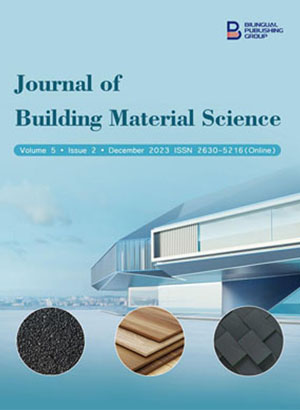
Characteristics of Rice Husk-Admixed Conplast SP 430 Concrete
DOI:
https://doi.org/10.30564/jbms.v5i2.5664Abstract
Experimental work was mounted using 5.7 mL of the Conplast SP430 admixture and rice husk ash (RHA) at replacement levels of 0 to 50% at 10% intervals by wt.% of cement. It is on the performance of Conplast SP 430 admixture and its effects on concrete and concrete with rice husk ash. Concrete specimens were cast and cured for 3 to 90 days and subjected to slump and mechanical characteristics tests. Data generated from the experiments were analyzed and sensitivity analysis of the concrete mix was determined using the Minitab 18 Statistical Package. The results showed that CP with concrete improves the workability of the concrete and reduces water absorption. The reverse was the case when RHA was used with the admixture which may be an issue of compatibility. The statistical characteristics restrict good and within the specified limits.
Keywords:
Rice husk ash; Admixture; Mechanical characteristics; Statistical analysisReferences
[1] Arrigoni, A., Panesar, D.K., Duhamel, M., et al., 2020. Life cycle greenhouse gas emissions of concrete containing supplementary cementitious materials: Cut-off vs. substitution. Journal of Cleaner Production. 263, 121465.
[2] Rehan, R., Nehdi, M., 2005. Carbon dioxide emissions and climate change: Policy implications for the cement industry. Environmental Science & Policy. 8(2), 105–114.
[3] Rahla, K.M., Mateus, R., Bragança, L., 2019. Comparative sustainability assessment of binary blended concretes using Supplementary Cementitious Materials (SCMs) and Ordinary Portland Cement (OPC). Journal of Cleaner Production. 220, 445–459.
[4] Supino, S., Malandrino, O., Testa, M., et al., 2016. Sustainability in the EU cement industry: The Italian and German experiences. Journal of Cleaner Production. 112, 430–442.
[5] Uchechukwu, E.A., Olakunle, J.O., Duna, S., 2022. Characteristics of ordinary Portland cement paste containing rice husk ash and conplast. Journal of Building Material Science. 4(1), 1–10.
[6] Van Tuan, N., Ye, G., Van Breugel, K., et al., 2011. The study of using rice husk ash to produce ultra high performance concrete. Construction and Building Materials. 25(4), 2030–2035.
[7] Cordeiro, G.C., Toledo Filho, R.D., Tavares, L.M., et al., 2011. Influence of particle size and specific surface area on the pozzolanic activity of residual rice husk ash. Cement and Concrete Composites. 33(5), 529–534.
[8] Chao-Lung, H., Le Anh-Tuan, B., Chun-Tsun, C., 2011. Effect of rice husk ash on the strength and durability characteristics of concrete. Construction and Building Materials. 25(9), 3768–3772.
[9] ASTM C 494-92: Standard Specification for Chemical Admixtures for Concrete [Internet]. Available from: https://www.astm.org/c0494_c0494m-19e01.html
[10] Fosroc Conplast SP430 [Internet]. Available from: https://fosroc.com/assets/HotSpotDocuments/Conplast-SP430.pdf
[11] BS EN 197-1:2011. Cement Part 1: Composition, Specifications, and Conformity Criteria for Common Cements [Internet]. Available from: https://knowledge.bsigroup.com/products/cement-composition-specifications-and-conformity-criteria-for-common-cements?version=standard
[12] ASTM C 618-12: Standard Specification for Coal Fly Ash and Raw or Calcined Natural Pozzolan for Use in Concrete [Internet]. Available from: https://webstore.ansi.org/standards/astm/astmc61812
[13] BS EN 12390-2:2019. Testing Hardened Concrete-Making and Curing Specimens for Strength Tests [Internet]. Available from: https://knowledge.bsigroup.com/products/testing-hardened-concrete-making-and-curing-specimens-for-strength-tests-2?version=tracked
[14] Elinwa, A., 2018. Mechanical strength of admixed Conplast SP 430 cement paste and concrete. Available from: http://dx.doi.org/10.2139/ssrn.3174640
[15] BS EN 12350-2:2019. Testing Fresh Concrete-Slump Test [Internet]. Available from: https://knowledge.bsigroup.com/products/testing-fresh-concrete-slump-test-2/tracked-changes
[16] BS EN 12390-7:2009. Testing Hardened Concrete Part 7: Density of Hardened Concrete [Internet]. Available from: https://standards.iteh.ai/catalog/standards/cen/5c244c2e-9414-4a0d-97db-96b3a2ddcc9b/en-12390-7-2009
[17] EN 1097-6:2022. Testing for Mechanical and Physical Properties of Aggregates-Part 6: Determination of Particle Density and Water Absorption [Internet]. Available from: https://standards.iteh.ai/catalog/standards/cen/7eb55eec-cf2d-449c-bdf5-45534b169181/en-1097-6-2022
[18] BS EN 12390-3:2019. Testing Hardened Concrete Part 3: Compressive Strength of Test Specimens [Internet]. Available from: https://standards.iteh.ai/catalog/standards/cen/7eb738ef-44af-436c-ab8e-e6561571302c/en-12390-3-2019
Downloads
How to Cite
Issue
Article Type
License
Copyright © 2023 Augustine Uchechukwu Elinwa, Johnson Olomi Olakunle

This is an open access article under the Creative Commons Attribution-NonCommercial 4.0 International (CC BY-NC 4.0) License.







 Augustine Uchechukwu Elinwa
Augustine Uchechukwu Elinwa






